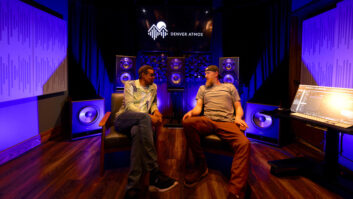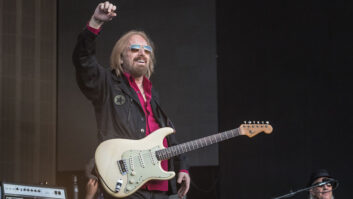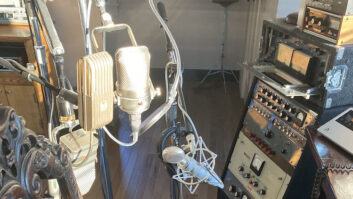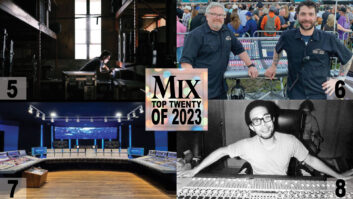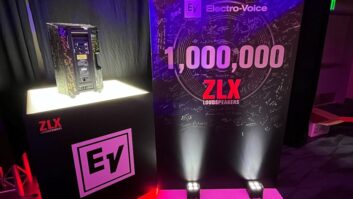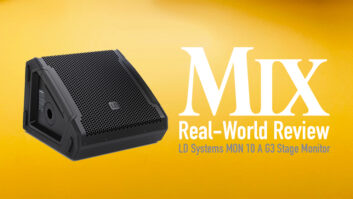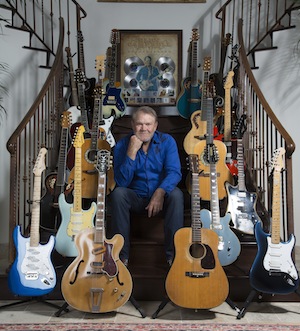
Two years ago, Glen Campbell’s family revealed that he is suffering from Alzheimer’s disease, and his fans assumed that his wonderful 2011 album Ghost on the Canvas must be his last. Campbell stopped touring this past April due to progression of the disease. It seemed that a long, brilliant career had reached its end.
However, Surfdog, the label that released Ghost, had a surprise in store. During the Ghost on the Canvas sessions, producer Julian Raymond and engineer Howard Willing had asked Campbell to perform some of his biggest hits—“Wichita Lineman,” “Gentle on My Mind,” “By the Time I Get to Phoenix” and others—as guide tracks, or just to keep the juices flowing in the studio. Now, on See You There, fans will get to hear those special performances, set to breathtaking new arrangements.
“There was a key moment when Glen’s tour was winding down, I grabbed a CD and put it on for the first time in a couple of years,” says label owner/executive producer Dave Kaplan. “I heard the first three words of ‘Hey Little One,’ and it melted me. I said, ‘This is so magical that it deserves to be a record.’”

Tom Weir (left) and Dave Darling
Kaplan brought the tracks to producer/engineer/guitarist Dave Darling, who’s perhaps most famous for his production work with Brian Setzer, and they brainstormed a plan to rearrange those iconic songs.
“Our earliest conversations had to do with Glen’s TV show,” Darling says. “That was in his mind—the fact that Glen would play a song on acoustic guitar and just sing it, in a folky way, at the end of the Glen Campbell Goodtime Hour [1969-1972].”
Darling says he and Kaplan wanted to make the new versions more “rootsy, closer to the ground,” to show an emotional quality that he and Kaplan heard in the performances. Darling gathered a core band of what he considers very sensitive players. Basic tracking happened in Studio City Sound (studiocitysound.com) with Steve Hodges on drums, Carl Sealove on upright bass and Darling on electric guitar. Studio City Sound’s chief engineer/owner, Tom Weir, tracked the sessions.
“We had the drummer alone in the big room of Studio A,” Weir recalls, “and bass in a side lounge that we use as an iso room.” Weir miked the bass fiddle with a Neumann M 149 down low and a KM 84 higher up to get some of Sealove’s finger sounds. “I used two API 3124 pre’s on those, but no EQ or compression,” he says. “If a bass sounds great, I’ll let that go into Pro Tools naturally. I like to leave acoustic instruments flat unless we’re going for an effect.”
“Steven Hodges is a particularly quiet drummer, so I had him miked up with about a gazillion ribbon mics,” Darling says.

Dave Darling
In addition to close-miking each piece of the kit, Weir says, “I also put a Neumann U 47 up—another mono mic in front of the drum set—and, for old-school blend, I put an extra Electro-Voice RE15 in the back, overhead.”
Darling’s electric guitar amp was placed in another iso room, miked with a Royer R-121 and a Shure SM57, with both mics going through a vintage 4-channel Ampex MX-10 mixer. “That old mixer was modified by Steve Firlotte of Inward Connections,” Weir says. “We have two of them at Studio City Sound, and one’s modified with phantom power. I blended the two guitar mics together when he played electric, and if he played acoustic, we’d record him with a KM 84 through an API 3124 pre.” Studio City Sound is long on API preamps, and Weir used several on drums, along with Neve, UA, EMI and Amek pre’s. “I still have the modules from the Amek Angela I had in my first studio,” Weir says. “Now we have preamps and no console. We put the toms through the A10.”
Some additional sounds went down during basics—Arlan Oscar on keys, Paul Cartwright on viola, Teddy Andriadis on harmonica—and still more during overdubs/mixing in Darling’s personal studio, Doghouse. Darling and Kaplan agree that some arrangements seemed to write themselves, while others proved more elusive. “’Rhinestone Cowboy’ was hard,” Darling says. “I did that song five times, but it was an important record, so it was worth doing.”
“For a while, it seemed like everything we did sounded like a lounge act playing ‘Rhinestone Cowboy’ with this brilliant vocal,” Kaplan says. “And it’s tough because you’re not going to get these songs better than the originals; they’re masterpieces.”
Whereas “Hey Little One,” for example, becomes more intense with Campbell’s voice in front of dark but intricate, full arrangements, this new version of “Rhinestone” is simplicity itself: Darling plays a striking, powerful electric guitar part, with some gentle acoustic strumming underneath. It’s almost painful to hear how lonely and full of feeling this song becomes in Darling’s hands, and it will surprise many that the vocal and guitar arrangements weren’t conceived together; it’s seamless.

“If this is the final studio record from Glen Campbell, I’m hoping more than anything that people are moved by it and have a heightened respect for one of the greatest musicians we’ve ever had on the planet,” Kaplan says. “This is not just another collection of hits—it gets to a whole new level of emotion.”
Check out the official video for “Hey Little One” here.
